|
What's a Pothead?
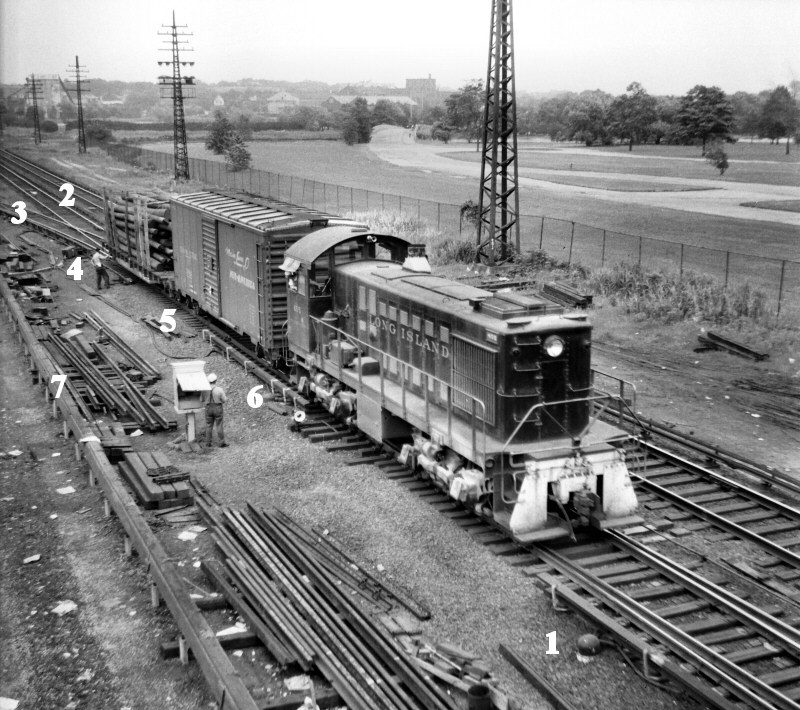
S2
#455 switching freight at Whitestone Jct. Flushing Meadows view SE
06/02/51 (Faxon-Keller)
|
|
1) That's a "pothead"
for the connection of an underground feeder cable to the third
rail. The underground duct would end in a curved piece,
coming out vertically. At the end of the duct, there would be
a terminal block here a bolted connection would be made to short
flexible cables that then connected to the 3rd rail. The
connection block would be covered with many layers of electrical tape,
then that concrete dome would be set on top. At switches and
at grade crossings, underground cables would be used to connect from one
piece of third rail to another.
2) At a guess, the third rail on this westbound track changes from
the north to the south side of the track at this turnout.
Somewhere behind the engine, the other end of the underground cable
would come up to another pothead and there would a connection to the 3rd
rail on the south side of the track (as is visible in the distance).
There are a number of interesting 3rd rail details in this picture - the
more I looked the more I could see. This is at what was
Whitestone Junction, and probably taken from the wide footbridge that
had led into the 1939 fair, and at this time just into the park.
That bridge was completely torn down and replaced by a new one for
the 1964 fair.
3) In the distance, the track curving off to the left is the remnant of
the Whitestone branch. Note that it still has 3rd rail! Until
the diesel switchers like this one began to arrive, in the late 40's,
local freight service in Queens and western Nassau was performed by DD-1
electric locomotives, in response to complaints (constantly amplified by
the Long Island Daily Press) about noise and smoke from steam engines.
So although MU
operation had long ended on the branch, the yard and sidings on
the stub still had third rail. By this time, it was probably not
used any more, as the DD-1s had been retired from freight service as
soon as the diesels came - before any steam power. By 1951,
the DD-1's were on the way out altogether - the last straw was the
introduction of Speed Control after the 3 bad wrecks - LIRR had to
minimize the number of motive power units needing that expensive
installation.
4) At the near end of the branch 3rd rail, you can see a small box on
the ground. This would contain a knife switch, so that the branch
3rd rail could be shut off when not in use. Switches
like this were provided at sidings, especially those that ran long
distances into coal trestles, lumber yards, etc.
5) Just east of the pothead is a gap in the third rail, because of
the turnout (which is probably a crossover between the two tracks).
A gap at this location ensures that a contact shoe on a car or engine
coming in on the crossover does not run into the side of the 3rd rail,
as it converges with the main track. (An alternative
solution is a "side approach", a sloping apron on a
continuous 3rd rail past the switch points; LIRR once used such
things in a few spots, but no longer).
6) There is a short length of 3rd rail under the engine cab.
This looks like it has just recently been installed. The
protection board brackets look freshly galvanized. Remarkably, it
seems to be fed by a cable just laid on the ground, with a few scattered
boards as protection. Wonder why??
7) Along the left side is another "feeder rail", on
concrete supports, carefully boxed in on all sides. No pothead for
connections to it appear, but there must be some.
All this area was greatly changed with the preparation for
service to the 1964 Worlds Fair. H. Raudenbush 3/02/2014
|
Feeder Rail
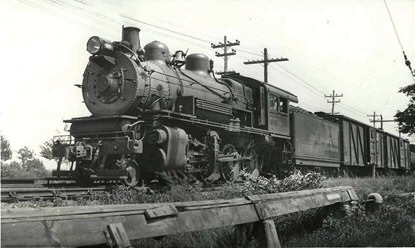
LIRR
#314 Mineola 1930's Photo: Ron Ziel
|
|
In this picture (LIRR
engine #314) note the object in the foreground - unique to the
LIRR; this is a "feeder rail". Where other properties
might use a copper cable, overhead or underground as a feeder, LIRR used
this arrangement. It is a piece of third rail, not mounted
beside a track, but mounted on concrete piers, and boxed in with
wood. These were used in a couple of places where there was single
track, but a need to feed power from a substation over more than one 3rd
rail.
I suspect that this
picture is not on the Main Line at Mineola, but rather on the track that
ran south from Mineola to Hempstead crossing, where it connected to the
Hempstead and Central branches. The crossing was a load
center - with Hempstead branch trains plus the Mitchell Field shuttle),
but the nearest substations were at Mineola, West Hempstead and
Hempstead, so feeder rails were used to provide additional conductivity
to the Crossing. That track from Mineola to Hempstead Crossing is
now long gone. Branching off of it was a spur to the Garden City
Waterworks. Also gone is a connection from Hempstead
Crossing to West Hempstead.
In the late 19th Century, after the general merger, many trains to the
Oyster Bay Branch and points east on the Main line were routed from
Floral Park through Garden City, then up this track to Mineola instead
of using the Main Line. Some years ago there still were a few
rails in the street crossing between the Mineola substation and Nassau
tower, remnants of connections used in this routing. Later the
LIRR's battery cars ran from Mineola through the Crossing, then down the
West Hempstead branch to Valley Stream. When the West Hempstead
branch was electrified, so was the connection from WH through Hempstead
Crossing to Mineola, and trains could be run in a loop, going out via
Valley Stream and back via Mineola, but I don't think this lasted long.
I haven't checked a roster, but I think 314 would have been an H-6
consolidation. H. Raudenbush 2/28/2014
Note: LIRR 2-8-0 #314
is a class H6sb consolidation. Info: Steven Lynch |
|
Substation
8 at Mineola
On my explanation of feeder rails,
with the picture of #314, somebody gave me a piece of information that
filled in some blanks. I had wondered why substation 8 was built
at Mineola around 1912, when there was no electrification there until
1926. It turns out that it was intended to feed the Hempstead
Branch, at Hempstead Crossing (before the small addition subs were built
at Hempstead and West Hempstead). My guess as to why
this was done was perhaps to run the
transmission line along the main line. A transmission line
with tall poles running through Garden City might have roused some
influential nimbies! Also, there was the possibility that
eventually the Main Line would be electrified; and in addition, the
transmission line also continued to Farmingdale, to feed a substation
there that powered the Huntington-Amityville trolley.
The shop switchers
320 and 322: They had batteries, and could run either from third
rail or the battery.
The transfer tables had third rail,
but the tracks inside the shops could not, hence the battery.
Power to the transfer table, both to move it, and for its 3rd rail,
was collected by a trolley pole mounted on top of the table’s
cab. The battery could be charged when the engine was on 3rd
rail.
The controller in the cab of the 320
and 322 was a drum type, similar to a streetcar K-type, directly
controlling the motor current. Because space in the cab was
limited, the controller was mounted at right angles to the usual
position – the operator facing the controller would be facing the
side, rather than the end of the engine. As a result the positions
of the reverse handle on the controller were not clear. Big arrows
were painted on the top of the controller to show which position of the
handle would move the engine in which direction!
Pump Cars
This is more a Pennsylvania RR/IRT
story, but in LIRR territory. At an early date, the IRT
learned that any time there is a water main break, the water will end up
in the subway, at a rate beyond the capacity of the normal drainage
pumping plant. About 1907, the IRT built a pump car, using the
underframe of a fire-damaged 1904 Composite passenger car. Like
all those cars, it had the usual Van Dorn improved link & pin
couplers, like all the el cars.
Some time about 1927, there was a huge
downpour in Long Island City, and the water ran in to the portals of all
four Penn station tunnels, flooding them and blocking all movement.
Some years ago, the PRR Technical & Historical Society news letter
had an article describing how Pennsy managed to turn and service all
their trains, including long distance trains with sleepers and diners,
without access to Sunnyside Yard!
The late Bill Eaton, who worked 49
years for the IRT/NYCT and later for LTK and MTA told this story.
He was sent with the IRT pump car to help the PRR. (The BMT pump
car was also borrowed by the PRR). At that time there was a little
2-car inspection shop at Hunterspoint Ave, with the track connected to
the IRT at one end and the railroad at the other end. The pump car
was towed over the Queensboro Bridge to that point, to be picked up by
the RR.
The crew arrived with a DD-1, took one
look at the pump car and exclaimed “Link & pin couplers!
That’s illegal! We can’t take that!” Bill had to point out
– look you have a flood, I have a pump car - let’s get together on
this!
One error in Bill Volkmer’s notes
about me (wow! How can I live up to what he says): I was born
about a train length from Jamaica Station – Jamaica Hospital at Van
Wyck & Jamaica Aves. Moved to New Haven when I was 1, and my
earliest recollections are train watching at New Haven station.
But when I was 5, we moved back to the Sunrise Homeland, living in
Bellaire at first.
Feeder Rails and
Substation Batteries
The feed must have gone by third rails
or feeder rails from Mineola to Hempstead crossing. As I remember,
the single track on that stretch also had negative feeder rails – two
rails in the middle of the track, only about a foot apart, and bonded at
the joints. This would provide a parallel path for the return
current. Spaced like that, they could not be guard rails, just
electrical feeders. Similar rails were provided on the Rockaway
Branch, to better feed through the long stretch from Substation 3 at
Woodhaven Jct to SS 5 at Hammels.
Hammels SS 5 originally also had a
large storage battery. When traffic was light, power could trickle
down the transmission line from LI City, through the rotary converters
and into the battery. Then on a sunny summer day, with huge crowds
in the Rockaway's, if a thunderstorm moved in and everybody decided to
head for home at once, the battery could meet the demand of sending all
the trains out in short order. |
|
LIRR M1 #9003 on DISPLAY at
HEMPSTEAD 1968
|
|
June 24, 1968, Car 9002 made first appearance in
Budd's production line - at the station where assembly of the
underframe began. (9002 was produced ahead of 9001, perhaps because
they wanted to start with an "A" car).
Sep 3, 1968: 9002 in the production line station where the floor,
sides and roof were assembled.
Oct 17, 1968: 9001-9002 arrived at LIRR (shipped Oct 16), overnight
via RDG from Budd to North Philadelphia, PRR from N. Philadelphia to 30th
St, then via NE Corridor through Penn Station to Harold interlocking.
Held at Harold through AM rush, then to Dunton Inspection shop at Jamaica.
This was the pattern for following cars until acceptance processing was
moved from Dunton to Shea Stadium.
Oct 21, 1968: 9003-04 arrived at LIRR.
Oct 24, 1968: 9005-06 arrived at LIRR
Oct 28, 1968: 9007-9010 arrived at LIRR
Oct 30, 1968: 9011-9012 arrived at LIRR
Nov 1, 1968: 9013-9014 arrived at LIRR
Note these are the first days these cars were recorded as being at LIRR.
In each case, they shipped from Budd in the evening of the previous
day.
|
|
I don't think the cars were displayed more than a day or
two at any one location; they were probably moved from one spot to another
frequently. (Hempstead, Port Washington, Long Beach, Penn Station,
and Babylon) Info: Matt Kobel [October 17, 1968 1st M-1 Pair displayed at
Sunnyside; October 28, 1968 1st M-1 public displays] 1968 PRR Chronology
Report.
A driving force in that period, perhaps, was that Nelson Rockefeller was
running for election as a Presidential candidate that fall, and it was
made clear to the MTA that it was important to get as much exposure of the
new cars before election day. This began on the morning after the first
pair was delivered from Budd to Harold interlocking, and parked on the
interchange siding just east of the tower until after the AM peak. Crews
of westbound trains were told to announce to passengers that the first of
the new cars could be seen there! As the first few cars came in, most of
them would be involved in pre-acceptance testing, installation of shoe
beams, etc, so this static display would have been concentrated in late
October. Somewhere in that period there was a formal media event at
Jamaica station, with a speech by the Governor followed by a trip to
Woodside and back. All this had to happen before Election Day.
Back in June, there had been a summit meeting of MTA Chairman Ronan with
officials of Budd and GE at which it was laid down that 14 cars MUST be at
the LIRR by the end of October (that was the original contract schedule,
but some delays had arisen).
Budd rose to the occasion. They worked out an agreement with their union
(UAW) that they would not put their usual production bonus plan into
effect until the 15th car, but would pay a premium on the first 14. They
plastered the plant with stickers showing a pumpkin with the legend
"14 by Halloween", as motivation. These came in two sizes - on
about 3 inches and one about 10 inches. Inside the electric locker door of
9014 was one of the large ones.
They did succeed in meeting this schedule, but the down side was that a
number of problems had to be overlooked until later. The LTK lead
inspector at Budd's plant used to tell them that "those pumpkins had
better turn into coaches!" Most of the problems, which led to a big
retrofit program, were not with Budd's design or work, but with the
systems supplied by their subcontractors - especially G.E., WABCO and
Motorola.
Cars 9017 and 9022 were shipped from Budd’s Red Lion
plant, where all the M-1’s were built, to Budd’s test lab at the
Hunting Park plant, where one was used for the specified compression
(“squeeze”) test and one for the climate room test (see below). When
the tests were over, they were shipped to the LIRR as a miss-mated pair.
Because of the routing to and from Hunting Park, this pair arrived at the
LIRR with 9017 at the east end, not conforming to the other M-1’s (even
number east, as in track and train numbers). Shortly after arrival,
this pair was turned on the wye of the Belmont Park branch.
While these cars were at the lab, cars 9018/9019 and 9020/9021 were
shipped from Red Lion to LIRR also as miss-mated pairs. Some
time later, the LIRR gathered all three of these pairs together and
correctly mated them.
|
|
CHAINING MEASURING
|
|
The use of MP for a survey station is incorrect, but
mileposts are so much more commonly used on a railroad, somebody was
thinking of that.
58462 feet, a little over ten miles would be just about
right for that location, measuring from Long Island City via the Montauk
Branch. Jamaica is 9.3 miles. If i remember right, mileposts
East of Jamaica are measured via the Montauk Branch, not via Woodside,
which would be a little further. Coincidentally, the distance
from Flatbush Ave to Jamaica is also shown as 9.3 miles.
Chaining in the US is done in increments of 100 feet.
Every 100 feet from the starting point is a location called a (survey)
"station". So station 582 would be 58,200 feet from the
starting point. It would be referred to as 582+00. The
number after the plus is the distance in feet from the previous station;
so 582+36 would be 58,236 feet from the starting (zero) point. "Chaining"
refers to the fact that in early days, the distances were measured
out with an actual chain. In early days, a distance of 66 feet
was a "chain" comprised of 100 links; this is still used by
British railways. You will see references in British fan
publications to a distance such as "6 miles, 11 ch." Currently
still in use by surveyors in route surveying and curve surveying along
with elevations.
The zero station might be the actual beginning of a line, or it may be an
arbitrary point. Most of the chaining of the IRT and BMT
begins from actual points where lines (or segments of lines) began. For
historical reasons, usually outward from downtown Manhattan. As a
result sometimes chaining runs in opposite directions on different
segments of the same line. The Lexington Ave. IRT from City Hall to
40th St is chained northward from a zero at City Hall. But the
extension to South Ferry and Brooklyn is chained southward from about
the same point.
To avoid having chaining run in opposite directions, the IND picked an
arbitrary point, probably about in the West 4th St station, and called it
Station 1000. This way, whether they extended south (numbers going
down) to Coney Island or north (numbers going up) to the top of the Bronx,
the numbers could run in a continuous series. They did not
foresee the Rockaway line, which might have gone below 0, but in the
event, they acquired the LIRR drawings, etc of that line, so used the LIRR
chaining, which comes from a zero at Long Island City.
Railroads seem to have used chaining for their civil engineering, but
mile posting for operational activities. Most railroads have
been worked over many times since they were built, with relocations and
cutoffs changing the length of the line. If they tried to keep the
mileposts spaces 5280 feet apart, the MP at the far end of the line
would have to be on wheels! Instead, after any relocation, there
will be two mileposts at an irregular spacing.
For example, the original PRR line between Trenton and
Philadelphia swung through the middle of Bristol, with many grade
crossings. About 1909, the PRR built a cutoff bypassing Bristol,
with grade separation, and shortening the line. Mileposts 66 and 67
are 4000 feet apart. The chaining in such a case will have what is called
an "equation". At some point on the drawings there will be
a line drawn across the line with two chaining numbers listed, one for the
chaining up to that point, a different one for the chaining going forward.
|
|
VAN IDERSTINE
|
|
The
Van Iderstine trucks always looked very elegant outside - like UPS
trucks today, always seemingly freshly painted and waxed. They
were a very dark blue, almost black with blue stripes. But,
when they stopped in front of the local butcher shop and opened the
door to pick up the scraps - the inside was something else!
Van
I's plant was located along Newtown Creek, beside the LIRR
Montauk branch, somewhere near Haberman - once described as the most
God-forsaken station location in NY City. Reminiscence from Henry
Raudenbush
|
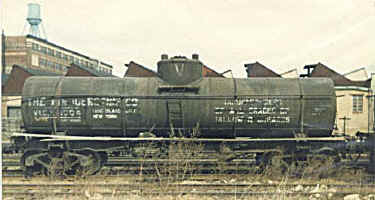
Van Iderstine Tank Car VICX 1004
|
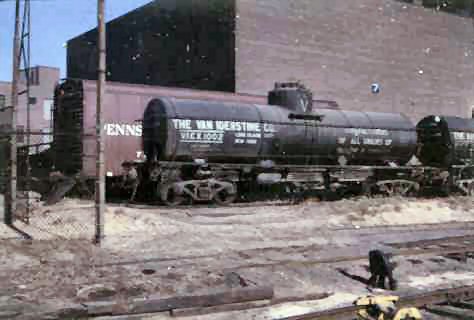
Tank Car VICX 1002, early 1963, Van Iderstine
Spots 5a - 5b Photo/Archive: Art Huneke
|
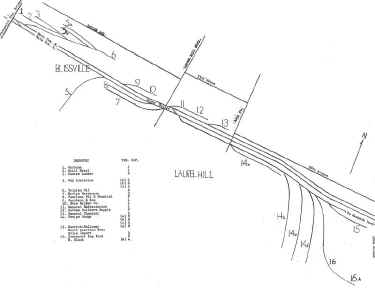
LIRR 1966 map Blissville-Laurel Hill
|
|
|




